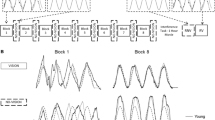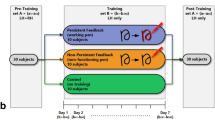Abstract
The stability and adaptability of visuomotor representations for hand movement in young children was investigated using a visuomotor adaptation paradigm in which the real-time visual feedback of pen movement was rotated 45° clockwise during exposure trials. Four, six, and eight-year-old children performed line drawings to visual targets, from a common centered position (“center-out task”), in the horizontal plane under normal (pre-, and post-exposure), and rotated (exposure) visual feedback conditions. Analysis of pre-exposure trials indicated that older children performed faster, straighter, smoother, and showed more patterned movements than the younger children. Initial direction of movement, computed at 80 ms after movement onset, showed a progressive tuning of movement direction with increasing age. On introduction of the screen cursor rotation, all age group children showed improvement in their planning (initial directional error) and execution (movement time, movement length, root mean square error, and normalized jerk) error scores from early to late-exposure trials, but the 4-year-olds were less affected than older age children by the distortion during the early exposure period. Moreover, only the oldest group of children showed significant after-effects during post-exposure trials indicating that only this age group learned the internal model of the distorted environment. The absence of after-effects for initial movement direction observed in the two younger age groups suggest that these children might have less developed (i.e. more broad) internal visuomotor representations for hand movements, and that their internal representations are sharpened (i.e. tuned) with visuomotor experience.







Similar content being viewed by others
References
Badan M, Hauert CA, Mounoud P (2000) Sequential pointing in children and adults. J Exp Child Psychol 75:43–69
Bard C, Hay L, Fleury M (1990) Timing and accuracy of visually directed movements in children: control of direction and amplitude components, J Exp Child Psychol 50:102–118
Bo J, Contreras-Vidal JL, Clark JE (2003) The effect of visuomotor transformation on children’s arm movement. J Sport Exercise Psychol 25:S29
Bullock D, Grossberg S, Guenther F H (1993) A self-organizing neural model of motor equivalent reaching and tool use by a multijoint arm. J Cogn Neurosci 5:408–435
Fayt C, Minet M, Schepens N (1993) Children’s adults’ learning of visuomanual coordination: role of ongoing visual feedback and of spatial errors as a function of age. Percept Motor Skill 77:659–669
Fayt C, Schepens N, Minet M (1992) Children’s development of reaching: temporal and spatial aspects of aimed whole-arm movements. Percep Motor Skill 75:75–384
Ferrel C, Bard C, Fleury M (2001) Coordination in childhood: modifications of visuomotor representations in 6- to 11-year-old children. Exp Brain Res 138:313–321
Graham K, Bradshaw MF, Davis A (1998) The effect of pre-movement delays on pointing accuracy in middle childhood. Perception 27:379–1387
Guigon E, Baraduc P (2002) A neural model of perceptual-motor alignment. J Cogn Neurosci 14:538–549
Hatwell Y, Sayettat T (1991) Visual and haptic spatial coding in young children. Br J Dev Psychol 9:445–470
Hay L (1990) Developmental changes in eye-hand coordination behaviors: preprogramming versus feedback control. In: Bard C, Fleury M, Hay L (eds) Development of eye-hand coordination across the life span. University of South Carolina, Columbia, pp 217–244
Hay L, Bard C, Fleury M, Teasdale N (1991) Kinematics of aiming in direction and amplitude: a developmental study. Acta Psychol (Amst) 77:203–215
Henderson SE, Sugden DA (1992) Movement assessment battery for children. The Psychological Corporation, London, UK
Hoare D (1994) Subtypes of developmental coordination disorder. Adapted Phys Act Quart 11:158–169
Imamizu H, Miyauchi S, Tamada T, Sasaki Y, Takino R, Putz B, Yoshioka T, Kawato M (2000) Human cerebellar activity reflecting an acquired internal model of a new tool. Nature 403:192–195
Jansen-Osmann P, Richter S, Konczak J, Kalveram KT (2002) Force adaptation transfers to untrained workspace regions in children. Exp Brain Res 143:212–220
Kagerer F, Contreras-Vidal JL, Stelmach GE (1997) Adaptation to gradual as compared to sudden visuomotor distortions. Exp Brain Res 115:557–561
Kosslyn SM, Margolis JA, Barrett AM, Goldknopf EJ, Daly PF (1990) Age differences in imagery abilities. Child Dev 61:995–1010
Kitazawa S, Goto T, Urushihara Y (1993) Quantitative evaluation of reaching movements in cats with and without cerebellar lesions using normalized integral of jerk. In: Mano N, Hamada I, DeLong MR (eds) Role of the cerebellum and basal ganglia in voluntary movement. Elsevier, Amsterdam, pp 11–19
Krakauer JW, Pine ZM, Ghilardi M, Ghez C (2000) Learning of visuomotor transformations for vectorial planning of reaching trajectories. J Neurosci 20:8916–8924
McDonnell PM (1979) Patterns of eye-hand coordination in the first year of life. Can J Psychol 33:253–267
McDonnell PM, Abraham WC (1981) A longitudinal study of prism adaptation to infants from six to nine months of age. Child Dev 52:463–469
Messier J, Kalaska JF (1997) Differential effect of task conditions on errors of direction and extent of reaching movements. Exp Brain Res 115:469–478
Mistry S, Contreras-Vidal JL (2004) Learning multiple visuomotor transformations: adaptation and context-dependent recall. Motor Control, in press
Norris SA, Greger BE, Martin TA, Thach WT (2001) Prism adaptation of reaching is dependent on the type of visual feedback of hand and target position. Brain Res 905:207–219
Olivier I, Rival C, Bard C, Fleury M (2003) Aged-related differences in the attentional cost of pointing movements. Neurosci Lett 338:169–173
Olivier I, Bard C (2000) The effects of spatial movement components precues on the execution of rapid aiming in children aged 7, 9, and 11, J Exp Child Psychol 77:155–168
Olivier I, Audiffren M, Ripoll H (1998) Age-related differences in the preparatory processes of motor programming. J Exp Child Psychol 69:49–65
Pine ZM, Krakauer JW, Gordon J, Ghez C (1996) Learning of scaling factors and reference axes for reaching movements. Neuroreport 7:2357–2361
Riddell PM, Horwood AM, Houston SM, Turner JE (1999) The response to prism deviations in human infants. Curr Biol 9:1050–1052
Rival C, Isabelle Olivier I, Hadrien Ceyte H (2003) Effects of temporal and/or spatial instructions on the speed–accuracy trade-off of pointing movements in children. Neurosci Lett 336:65–69
Sober SJ, Sabes PN (2003) Multisensory integration during motor planning. J Neurosci 23:6982–6992
Swanson HL (1996) Individual and age-related differences in children’s working memory. Memory Cogn 24:70–82
Thomas JR, Yan JH, Stelmach GE (2000) Movement substructures change as a function of practice in children and adult. J Exp Child Psychol 75:228–244
Wada Y, Kawabata Y, Kotosaka S, Yamamoto K, Kitazawa S, Kawato M (2003) Acquisition and contextual switching of multiple internal models for different viscous force fields. Neurosci Res 46:319–331
Acknowledgments
This work was supported by the University of Maryland’s Center for Neuroscience and National Institutes of Health HD42527. We wish to thank the children and their parents for their participation in this study.
Author information
Authors and Affiliations
Corresponding author
Rights and permissions
About this article
Cite this article
Contreras-Vidal, J.L., Bo, J., Boudreau, J.P. et al. Development of visuomotor representations for hand movement in young children. Exp Brain Res 162, 155–164 (2005). https://doi.org/10.1007/s00221-004-2123-7
Received:
Accepted:
Published:
Issue Date:
DOI: https://doi.org/10.1007/s00221-004-2123-7




